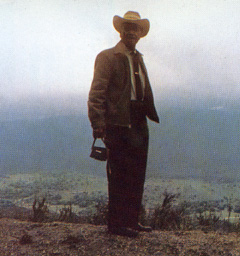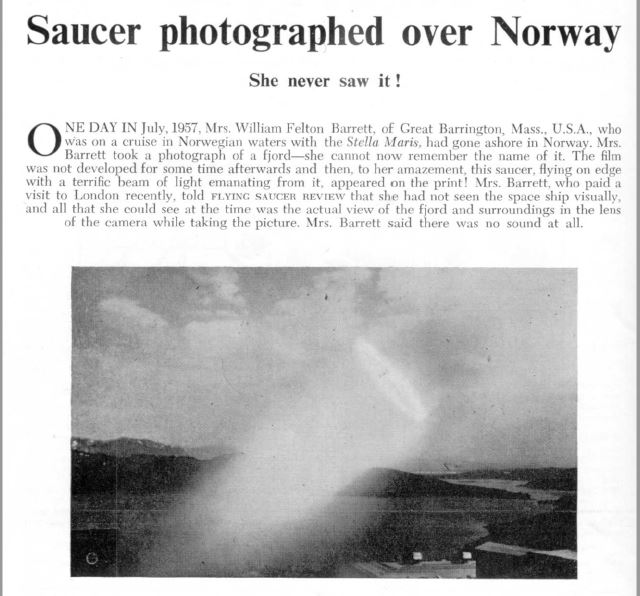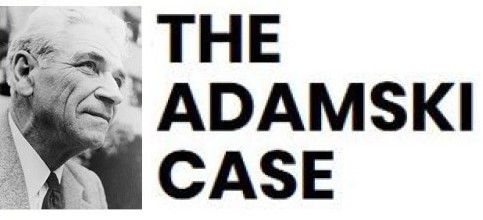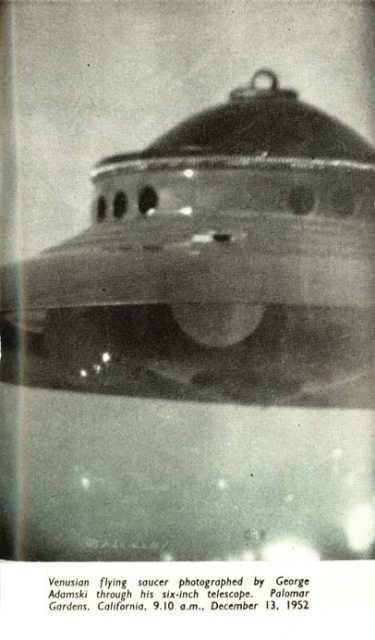(Image: George Adamski, 13 December 1952. Source: utexas.edu.)
More than any other photographs of extraterrestrial space craft, George Adamski’s have always been a bone of contention, mostly because of the way sceptics have set up their argument: UFO photos that are fuzzy don’t prove anything (1950s: Weather balloon! 2010s: Drone!), and if they are detailed they are simply too good to be true, so they must have been faked.
Ironically, though, while unbiased experts at the time agreed that Adamski’s photos were authentic, detractors never managed to agree on exactly what item he allegedly used to ‘fake’ his photos, proclaiming it was a street light, the top of an Italian ice machine or a tobacco humidor, a 1930s lantern, or the top of a chicken brooder — to name only a few of the ‘smoking guns’ that have been presented over the decades since he took his now iconic photos of a Venusian scout ship.

Yet, long before Rene Erik Olsen (Denmark), Bastien Bouhaniche (France), and others published the results of their extensive research 🔗, photographic experts investigated Adamski’s photos and concluded that they could only be the real thing. We collect here the verdicts of these experts from the days before digital photography and app filters made fakery generally available.
J. Peverell Marley, who had served with the Enemy Interceptor Command in World War II and later became a celebrated cameraman who worked with director Cecil B. DeMille, stated that “Adamski’s pictures, if faked, were the cleverest he had ever seen”. He pointed out that “the shadows on the saucers, and also on the ground, corresponded to such a remarkable degree that they could not be faked, and that to fake such pictures would require costly equipment which Adamski, obviousy, does not possess and which, even then, could not assure such a result.” (Source: Meeting of Air Force Reserve Officers on flying saucer activity, 1 June 1953. Note: According to James Moseley, when asked Mr Marley later denied making this statement, although such denials are not at all uncommon in a field so ridden with controversy as Ufology.)
Fourteen experts of the J. Arthur Rank film distribution company (UK) “concluded that the object photographed was either real, or a full scale model”. (Source: Leonard Cramp, aeronautical designer and engineer, in his book Space, Gravity, and the Flying Saucer, 1954.)
Joseph Mansour, head of Jetex Model Aircraft Company (UK) and expert model photographer: “The reasons that I believe Adamski’s photographs are not of models is that I think he himself is incapable of making a model sufficiently good from which these photographs could be faked. . . . I think it would have been extremely dangerous for him to have attempted a fraud of this description, and the contraption attached to his telescope which was used for photographing saucers leaving the moon etc. is so amateurish that this was another reason why I concluded that he himself had not used a model, as either he or possibly his photographer friend would have had to make it in the first place.” It was his opinion that “it would be impossible without the expenditure of a large sum of money, and doubtfully even then, to make any model resemble the strange craft…” (Source: Letter to Waveney Girvan, editor of Flying Saucer Review, dated November 1954)
William Sherwood, an optical physicist at Eastman Kodak company (USA), examined some of Adamski’s later films of a flying saucer, taken in Silver Spring, MD, 1965, that were known not to have been tampered with by third parties. Describing the various techniques and technologies used for his analysis, he says: “Everything pointed to the conclusion that the objects in the film were true, unknown objects, not model objects”. (Source: Interview with William Sherwood 🔗 in Michael Hesemann’s documentary UFOs: The Contacts – The Pioneers of Space, 1996.)
In a letter to Ronald Caswell Mr Sherwood later wrote: “When Mr Adamski came to Rochester in March, 1965, I took him to Eastman Kodak Co. and introduced him to scientists and photographic specialists in the optical laboratory. (…) They accepted his films as genuine. A typical comment was: ‘We wouldn’t begin to know how to fake such a film if we wanted to…’.”
In the same documentary Bob Oeschler, not a photography expert but a NASA physicist and Mission Specialist, had this to say about the Silver Spring footage (the ‘Rodeffer film’):
Note: The history of how this footage was tampered with and wrongly discredited is recounted at length by Rangvald Carlson (Ronald Caswell) in ‘UFO Contact: The Day Before Yesterday 🔗’, Series One, Part Eight. Five of the original frames were enhanced 🔗 by Rene Erik Olsen.
Many of the ‘anomalies’ in Adamski’s and other photographs of UFOs cannot be explained by means of straightforward physics, yet the nuts-and-bolts crowd conclude that they must be faked. Also, it should be remembered that these craft have been reported by people around the world to possess extraordinary capabilities. These are not only related to highly advanced technology, but also to the fact that these ships exist on the higher planes of matter — etheric matter 🔗, which is where the ‘missing’ 90 per cent of the mass of the universe 🔗 may be found, currently explained by the hypotheses of ‘dark matter’ and ‘dark energy’. If we could see these higher planes of matter we would also understand why Adamski and many other contactees maintained that their contacts hail from within our solar system, despite current scientific conclusions that none of the planets in our solar system are inhabited.
Because the space craft are in etheric matter, more often than not they appear, in photographs or to the naked eye, as lights or light formations, unless they lower the rate of vibration of the etheric (subatomic) particles that make up the craft, to fall within our range of vision. Not wanting to complicate matters, at a conference in Denmark in 1963 Adamski simply put it thus: “The golden solar saucers are ordinary saucers of the same kind which may be seen today – it is technical and atmospheric conditions that cause the golden glow.”
People who capture these ships are often unaware of anything unsual at the time of taking the photograph, only to find a craft, or an etheric ‘reflection’, in their photos when they review their pictures on screen or in print. Two examples, over 30 years apart in time, serve to illustrate how common this is. The first is a photograph taken over a fjord in Norway in July 1957, which was later used for the cover of the English edition of Dino Kraspedon’s book My Contact With Flying Saucers 🔗:

The second example shows a huge craft over the Valle Sagrado in Urubamba, near Cuzco, Peru. This photo, taken on 16 February 1989, was one of two in which the craft appeared when they were developed and printed, while nothing was visible to the photographer or the people standing by the roadside:

Interestingly, the appearance of the craft in this photo is reminiscent of a description of a craft that George Adamski gave in Pioneers of Space (1949): “She has a chisel-type nose and a fan shape tail. She has fins on her, something like fish, very close to the body.” (p.123)
Adamski himself hinted at the etheric physical nature of extraterrestrial life 🔗 when he wrote in 1946: “Even upon planets whose atmosphere is so rare that life seems impossible there may be intelligent forms existing — forms having the power of reason such as we possess, but the actual physical construction may be so fine as to be almost invisible to our sight, limited as it is to this particular plane of manifestation.”
We can only assume that it was because of the scope and significance of his mission to broaden humanity’s view of life that George Adamski was given the privilege of taking some of the clearest photographs of extraterrestrial space craft in full physical density to date.
FAIR USE NOTICE: This page may contain (links to) copyrighted materials the use of which has not been specifically authorized by the copyright owner. The Adamski Case publishes (links to) these materials solely for educational and research purposes, constituting Fair Use in accordance with Title 17 U.S.C Section 107 of the US Copyright Law, and Article 5 of the European Directive 2001/29/EC. Please contact The Adamski Case about any copyright or attribution issues.

